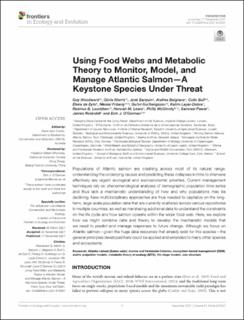| dc.contributor.author | Woodward, Guy | |
| dc.contributor.author | Morris, Olivia | |
| dc.contributor.author | Barquín, José | |
| dc.contributor.author | Belgrano, Andrea | |
| dc.contributor.author | Bull, Colin | |
| dc.contributor.author | de Eyto, Elvira | |
| dc.contributor.author | Friberg, Nikolai | |
| dc.contributor.author | Guðbergsson, Guðni | |
| dc.contributor.author | Layer-Dobra, Katrin | |
| dc.contributor.author | Lauridsen, Rasmus B. | |
| dc.contributor.author | Lewis, Hannah M. | |
| dc.contributor.author | McGinnity, Philip | |
| dc.contributor.author | Pawar, Samraat | |
| dc.contributor.author | Rosindell, James | |
| dc.contributor.author | O'Gorman, Eoin J. | |
| dc.date.accessioned | 2022-03-11T08:41:15Z | |
| dc.date.available | 2022-03-11T08:41:15Z | |
| dc.date.created | 2022-02-17T18:33:05Z | |
| dc.date.issued | 2021 | |
| dc.identifier.citation | Frontiers in Ecology and Evolution. 2021, 9, 675261. | en_US |
| dc.identifier.issn | 2296-701X | |
| dc.identifier.uri | https://hdl.handle.net/11250/2984501 | |
| dc.description.abstract | Populations of Atlantic salmon are crashing across most of its natural range: understanding the underlying causes and predicting these collapses in time to intervene effectively are urgent ecological and socioeconomic priorities. Current management techniques rely on phenomenological analyses of demographic population time-series and thus lack a mechanistic understanding of how and why populations may be declining. New multidisciplinary approaches are thus needed to capitalize on the long-term, large-scale population data that are currently scattered across various repositories in multiple countries, as well as marshaling additional data to understand the constraints on the life cycle and how salmon operate within the wider food web. Here, we explore how we might combine data and theory to develop the mechanistic models that we need to predict and manage responses to future change. Although we focus on Atlantic salmon—given the huge data resources that already exist for this species—the general principles developed here could be applied and extended to many other species and ecosystems. | en_US |
| dc.language.iso | eng | en_US |
| dc.publisher | Frontiers | en_US |
| dc.rights | Navngivelse 4.0 Internasjonal | * |
| dc.rights.uri | http://creativecommons.org/licenses/by/4.0/deed.no | * |
| dc.title | Using Food Webs and Metabolic Theory to Monitor, Model, and Manage Atlantic Salmon—A Keystone Species Under Threat | en_US |
| dc.type | Peer reviewed | en_US |
| dc.type | Journal article | en_US |
| dc.description.version | publishedVersion | en_US |
| dc.rights.holder | Copyright © 2021 Woodward, Morris, Barquín, Belgrano, Bull, de Eyto, Friberg, Guðbergsson, Layer-Dobra, Lauridsen, Lewis, McGinnity, Pawar, Rosindell and O’Gorman | en_US |
| dc.source.pagenumber | 10 | en_US |
| dc.source.volume | 9 | en_US |
| dc.source.journal | Frontiers in Ecology and Evolution | en_US |
| dc.identifier.doi | 10.3389/fevo.2021.675261 | |
| dc.identifier.cristin | 2003045 | |
| dc.source.articlenumber | 675261 | en_US |
| cristin.ispublished | true | |
| cristin.fulltext | original | |
| cristin.qualitycode | 1 | |

